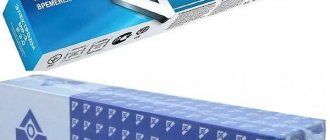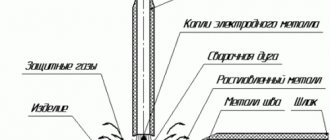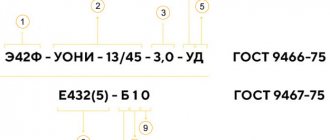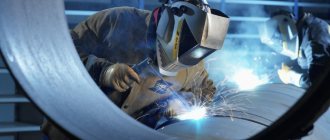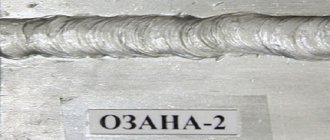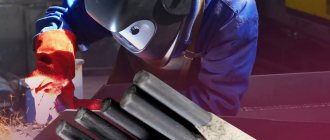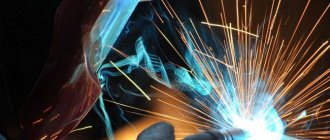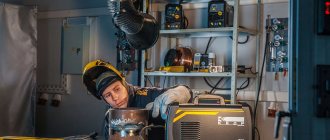Description and scope of application
The consumable type is a steel rod with a protective coating. Under the influence of high temperature, the coating burns out and turns into a gas, separating the molten metal from the oxygen of the atmospheric air.
Most electrodes of this type are used for the manufacture of:
- lightly loaded structures;
- thin-walled pipes and low-pressure tanks.
It is allowed to carry out surfacing repairs with their help.
The scope of application depends on the brand of E42 electrodes. They are available in different designs, differing in diameter and composition of the protective coating.
Improved SSSI E42A
The only variety with basic coating.
It contains phosphorus compounds and carbides, prevents the appearance of hot cracks and gives the weld the following properties:
- plastic;
- impact strength.
These features are indicated by the index “A” in the marking.
They allow the use of E42A type electrodes for the manufacture of structures:
- placing high demands on reliability, including those experiencing alternating loads;
- operated at low temperatures.
UONI E42A electrodes contain phosphorus compounds and carbides.
Consumables are produced in the UONI 13/45 category and have the following distinctive features:
- They work only with direct current of reverse polarity (electrode-positive).
- They require cleaning the joined workpieces from rust, oil stains, dirt and water.
- Not suitable for welding in high humidity conditions.
- They are used economically due to the presence of iron powder in the coating, which compensates for the loss of metal due to evaporation and splashes.
UONI E42A electrodes are intended for the manufacture of critical structures in the workshop.
They are capricious, so the welder requires experience and dexterity. Inverter-type welding machines are used; rectifiers are not capable of ensuring stable arc burning. The current should not be increased, as this has a bad effect on the quality of the seam.
Types of coating and diameters
In addition to the main coating, the following is used:
- Sour. It contains oxides of iron, silicon and manganese. Such electrodes are used to weld with caution due to the high probability of so-called formation in the seam. hot microcracks (intergranular fractures).
- Rutile. Rutile is a mineral with large amounts of titanium dioxide. The consumables coated with it form a plastic seam, the level of deoxidation corresponding to semi-quiet steel. They tolerate high current well and do not allow the appearance of hot microcracks.
Acidic electrodes contain oxides of iron, silicon and manganese.
Acid and rutile electrodes of the E42 type are produced under many brands, for example OMA-2, VSTs-4 and 4M, Ogonyok, OZS-23, ANO-6, 6M, 17, etc. They cook well not only permanently, but also AC powered and suitable for beginners.
The diameter of E42 consumables is 2-12 mm. It is selected in accordance with the thickness of the smaller workpiece. This parameter determines the current strength. Thus, to weld corner No. 5 according to GOST 8509-93 with a flange thickness of 6 mm, an electrode of size 4 (mm) is required. The amperage is 120-200 A.
Thick consumables are used to connect massive parts in one pass. In this they are superior to semi-automatic installations on non-consumable electrodes with filler wire supply.
Explanation of markings
The letter “E” means “electrode for manual arc welding”, the number 42 is the temporary tensile strength, which is 42 kgf/sq. mm.
We recommend reading Which aluminum electrodes to choose
The full electrode marking also contains other data, for example E42A-UONI-13/45 SM-4.0-UD GOST 9467-60.
Explanation of product markings:
- SM-4.0 – made of welding wire with a diameter of 4 mm.
- U - intended for welding carbon steel.
- D – has a thick coating. Other options: S – medium, M – thin.
The product meets the requirements of GOST 9467-60.
Decoding the names of electrodes.
Steel surfacing wire for electrodes
Steel surfacing wire is manufactured in accordance with the requirements of GOST 10543. The wire diameter ranges from 0.3 to 8.0 mm. Material: low-carbon, alloy or high-alloy steel.
There are surfacing wires made from carbon steel (grades Np-25, Np-40, etc.), from alloy steel (grades Np-40G, Np-50G, Np-30KhGSA, etc.) and from high-alloy steel (grades Np-20Kh14, Np-30Х13, Нп-30Х10Г10Т, etc.). The grade of wire is selected based on the required strength of the welded joint, depending on the purpose of the welded structure.
Depending on the type of surface, steel welding and surfacing wire can be copper-plated or non-copper-plated. Copper-plated wire is supplied upon customer's request. The surfacing wire from which electrodes for manual arc welding are made is symbolized by the letter E.
Electrode characteristics
Consumables are made from welding wire Sv-08 or Sv-08A (GOST 2246-70). Its length is 45 cm.
GOST and other requirements
The necessary technical characteristics and designation rules for electrodes are given in GOST 9466-75 and 9467-75. According to these documents, the manufacturer is required to label the packaging. Some companies indicate it on the product itself.
What metal does it apply to?
E42 consumables are used for welding the following types of steels:
- carbon;
- low-alloy, for example grades 09G2 and 14G2.
E42 consumables are used for welding carbon steel.
They are not suitable for working with copper and other non-ferrous metals.
Physical and chemical properties of the seam
The composition of the electrode and its coating must provide the following indicators:
- Temporary tensile strength – 42 kgf/sq.m. mm.
- Relative elongation – up to 22%.
- Impact strength (resistance to brittle fracture, cold brittleness) – 150 J/sq. cm at +20°C and 35 at -40°C.
- Surfacing coefficient – 10 g/A*h.
- Consumption per 1 kg of seam – 1.6 (kg).
Content of chemical elements in the product core:
- Carbon (C) – 0.08%.
- Manganese (Mn) – 0.7%.
- Silicon (Si) – 0.1%.
- Sulfur (S) – 0.035%.
- Phosphorus (P) – 0.035%.
Welding electrodes are necessary when creating metal structures.
Operating temperature range – from -20°C to +20°C.
For electrodes less than 3 mm
The consumption per 1 kg of seam is 1.6 kg, and the bend angle is 150°.
The share of chemical elements in the weld metal or surfacing:
- sulfur – no more than 0.04%;
- phosphorus – up to 0.045%.
Temporary tensile strength – 42 kgf/sq.m. cm.
Features of operation
E42 electrodes are easy to use, easy to ignite and withstand voltage surges well. Most types weld rusty and damp metal without losing the strength and ductility of the joint.
The slag crust on the weld surface is easily separated, which reduces the cost and speeds up finishing.
Welding modes
This concept denotes actions and parameters designed to ensure high quality welds under given conditions.
Welding modes provide high quality seams.
Indicators are divided into 2 groups:
- basic;
- additional.
The first include:
- type and strength of current;
- electrode diameter;
- arc voltage.
Additional:
- spatial position of the seam;
- speed of movement of the consumable;
- composition and thickness of the metal.
E42 electrodes are used to cook with direct and alternating current, in the first case with reverse polarity. The amperage is related to the diameter of the consumable and the thickness of the workpieces being connected.
The data is summarized in the table:
We recommend reading Composition of electrode coating
| Thickness of welded parts, mm | 0,5 | 1-2 | 3 | 4-5 | 6-8 | 9-12 | 13-15 | 16 |
| Electrode diameter, mm | 1 | 1,5-2 | 3 | 3-4 | 4 | 4-5 | 5 | 6-8 |
| Current strength, A | 10-20 | 30-45 | 65-100 | 100-160 | 120-200 | 150-200 | 160-250 | 200-350 |
Wrong choice of electrode leads to the fact that the diameter becomes:
- Reduced. The coating is damaged and the arc loses stability.
- Enlarged. The current density drops and the arc is drawn across the surface of the workpiece. Because It is difficult to maintain a constant length, the seam becomes crooked and loses strength.
The welding mode is selected taking into account the capabilities of the inverter, i.e. maximum amperage for this model. Vertical and ceiling seams are welded with a consumable with a diameter of 4 millimeters, regardless of the thickness of the parts being connected.
The welding mode is selected taking into account the capabilities of the inverter.
The speed of the process affects the width of the seam. When moving quickly, it narrows, and vice versa. It is necessary to maintain the optimal speed, determined empirically.
Otherwise, the following consequences are observed:
- Acceleration. The material does not have time to warm up and melt, the joint turns out to be poorly welded.
- Slowdown. The metal flows out, the cross-section of the surfacing and, as a result, its strength decreases.
The optimal arc length is 3-4 mm. Stretching has a negative effect:
- During the journey from the electrode to the workpiece, the metal has time to oxidize.
- The arc is drawn across the surface, the heat is distributed over a larger area, and the material warms up worse. Melted drops freeze on it, clogging the seam.
The width of the joint and the penetration depth depend on the trajectory of the consumable. In addition to linear movement, zigzag and herringbone are used.
Existing restrictions
E42 consumables are not suitable for the following conditions:
- Perform vertical seams from top to bottom. Metal from the weld pool flows onto the untreated area.
- Connections of workpieces made of medium and high alloy steel, cast iron, non-ferrous metals.
- Welding with direct current of straight polarity (electrode-negative).
Consumables E42 are not suitable for vertical seams.
In the latter case, the cathode is the consumable. Compared to the anode, its temperature is higher (for melting products).
The parts being connected heat up worse, the penetration depth decreases; the coating on the electrode burns out too quickly and does not provide the required protection to the joint.
Is it possible to work with stainless steel?
Such materials are welded with electrodes containing nickel and chromium. E42 does not belong to this category, therefore it is not suitable for working with stainless steels.
Electrode storage
The coating of consumables, due to its porous structure, is hygroscopic, i.e. has a tendency to absorb moisture. Damp coating crumbles and burns poorly, as a result of which the seam does not receive protection from atmospheric oxygen and becomes weak and brittle.
Therefore, the following requirements are put forward for the storage location of electrodes:
- Relative humidity – less than 50%.
- The readings on the thermometer are not lower than +15°C. This means that during the cold season, consumables should be in a heated room.
- No temperature changes.
- Protection from direct sunlight.
If the packaging is opened, it is recommended to place the consumables in a special sealed case.
Points 2 and 3 are designed to prevent moisture condensation on products.
The specified conditions are also met if the electrodes are in sealed original packaging. With high humidity, they can become damp over time.
If the packaging is opened, it is recommended to transfer the consumables into a special sealed case with insulated walls. You can make it yourself from a plastic pipe of medium or large diameter.
We recommend reading Description of rutile-coated electrodes
Before use, the products are calcined, i.e. heated to dry the coating. The procedure time and temperature are indicated on the packaging; you must strictly adhere to them. Overheating is especially dangerous for consumables with organic substances in the coating.
Dried electrodes are suitable for use for 8 hours. If they have not been used during this time, the calcination can be repeated. But the number of procedures is limited and for different models it is 2-4. Subsequent heating will cause the coating to peel off.
Protective coatings for electrodes for manual arc welding
The protective coatings applied to the electrodes include various components that perform specific functions:
1. Gas-forming components. These include inorganic substances, such as marble CaCO3 and magnesite MgCO3, etc., and organic substances, such as starch, wood flour, etc.
2. Slag-forming components. These substances form the basis of the protective coating. Most often, the role of slag-forming agents is played by ores (manganese, titanium) or various minerals (ilmenite concentrate, rutile concentrate, feldspar, silica, granite, chalk, fluorspar, etc.).
3. Alloying elements and deoxidizing elements. These are silicon, manganese, titanium, nickel, chromium, etc. Aluminum is often used as a deoxidizing agent, which is introduced into the coating in the form of metal powder.
4. Binding components. The main component used to bind all components is liquid glass. Liquid glass is aqueous solutions of potassium and sodium silicates.
5. Molding elements. These are substances that give the coating plasticity. For this purpose, bentonite, kaolin, dextrin, mica and other components are used.
To ensure smooth burning of the electric arc, the coating composition includes alkali metal salts, liquid glass, etc. To increase productivity, the coating composition includes iron powder, the share of which can reach 60% of the total mass of the coating.
Successful analogues for replacement
E42 electrodes are widespread and are produced by all major manufacturers. Therefore, the need to look for an alternative rarely arises. If it does exist, use consumables similar in composition from Esab (Sweden).
The choice of model depends on which brand of E42 electrode requires replacement:
- ANO-6 – Esab OK 46.00.
- OZS-23 and OMA-2 – OK 43.32.
- WCC-4 – OK Pipeweld 6010. This consumable is no longer produced; the remaining stock in warehouses is being sold.
Manufacturers are developing new types of electrodes.
Manufacturers are constantly developing new types of electrodes, so it is possible that new analogues of E42 will appear in the future. They should be selected according to the chemical composition and coating material. For most E42 it is rutile, and the rods are made from welding wire Sv-08 or Sv08A according to GOST 2246-70.
Features of welding carbon steels
The key requirement when welding parts made of carbon steels is the strength characteristics of the weld metal and heat-affected area: they must correspond to the characteristics of the base metal. The higher the proportion of carbon, the more difficult it is to obtain a compound that strictly meets this requirement. Therefore, each group of carbon steels has its own welding characteristics.
Welding low carbon steels
This is a group of highly weldable, most ductile carbon steels due to their low carbon content and alloying additives. Welding can be performed using any known technologies, including manual electric arc welding.
However, this chemical composition of the metal also causes its own characteristics: if the electrode is chosen incorrectly, there is a risk that the weld metal will be stronger than the metal of the part, which can negatively affect the overall strength of the structure. And when performing multilayer welding, increased fragility of the weld metal is possible.
To avoid these problems, electrodes with rutile and calcium fluoride coatings are usually used for welding, and a proportion of iron powder is added to the coating. Among the low-carbon steels widely used for professional welding are the grades MR-3LUKS, MR-3, OZS-4, ANO-4, ANO-21, OZS-12, MK-46.00, UONI-13/55, UONI 13/45, SSSI 13/85.
To obtain the necessary strength properties, the weld metal is forged and calcined after welding.
ANO-21 STANDARD Current - alternating or direct of any polarity
RUR 224.40 ? with VAT per 1 kg.
MR-3 LUX (NAKS) Current - constant reverse polarity, alternating
201.12 rub. ? with VAT per 1 kg.
MR-3 (NAKS, RRR) Current - alternating or direct, reverse polarity
RUB 189.24 ? with VAT per 1 kg.
OZS-4 (NAKS) Current - alternating or direct polarity (plus on the electrode)
RUB 193.92 ? with VAT per 1 kg.
Electrodes for medium carbon steels
The amount of carbon in such alloys is greater, and accordingly, the welding process is more complicated. The downside is that the metal of the welded joint and the metal of the part may have different strengths. In addition, the metal near the edges of the seam can turn out to be very brittle and with characteristic cracks. To avoid this, electrodes with a sufficiently low carbon content are used.
Particular attention should be paid to the edges of the parts being connected. They must be cut to avoid metal penetration, which can be caused by high currents - they are necessary for heating the parts being connected.
You should also consider:
- to improve the quality of the weld, the parts, as mentioned above, are preheated and heated during the welding process;
- It is better to move the electrode not across, but along the joint;
- welding is best performed with a short arc;
- After welding, for greater strength, the seam is also forged and heat treated.
Among the well-known electrodes that are used for welding medium-carbon steels are grades UONI-13/55, UONII 13/55, UONII 13/45A, UONI-13/65.
Welding high carbon steels
Such steels have a high carbon content, which practically makes them unsuitable for welding various structures. Welding work, as a rule, is performed only when repairs are necessary.
In this case, the same technologies are used as when welding medium-carbon steels. The metal in the weld area is preheated to 250-300 °C; upon completion of welding, the weld is forged and heat treated. Two more conditions must be observed - welding is possible at a temperature not lower than -5 degrees Celsius in a room where there are completely no drafts.
Certificate of Quality
The legislation of the Russian Federation requires that this document be obtained only for electrodes intended for work:
- In the navy. Certificates are issued by river and sea registers.
- In hazardous industries. The papers are issued by Rostechnadzor.
Manufacturers are not required to certify general purpose electrodes. But many do this on their own initiative in order to convince the buyer of the high quality of their products. Before purchasing consumables, it is recommended to ask the seller whether they have a certificate. Its presence will serve as a solid argument in favor of purchasing this brand.
Certificate for electrodes.
Famous manufacturers
The largest manufacturers of welding electrodes, incl. type E42 are:
- NPO Spetselektrod LLC.
- LEZ.
- SZSM.
- OJSC Losinovsky Electrode Plant.
- LLC "Ural Electrode Plant"
- PJSC "Plazmatek"
- "Hobacks."
- Monolith.
- "Bridge".
- Esab.
- Kobleco.
- Lincoln Electric.
Well-known manufacturers of welding electrodes.
The history of each enterprise goes back decades. Research work is being carried out in laboratories, the result of which is the emergence of new, more effective rods and coatings. The fleet of equipment, including those used for quality control, is constantly updated. Thanks to this, almost 100% of defects are detected before products are sent to stores.
Part of them undertakes the execution of individual orders with the characteristics provided by the buyer.
